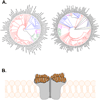Mammalian touch catches up
- PMID: 26100741
- PMCID: PMC4577443
- DOI: 10.1016/j.conb.2015.05.003
Mammalian touch catches up
Abstract
An assortment of touch receptors innervate the skin and encode different tactile features of the environment. Compared with invertebrate touch and other sensory systems, our understanding of the molecular and cellular underpinnings of mammalian touch lags behind. Two recent breakthroughs have accelerated progress. First, an arsenal of cell-type-specific molecular markers allowed the functional and anatomical properties of sensory neurons to be matched, thereby unraveling a cellular code for touch. Such markers have also revealed key roles of non-neuronal cell types, such as Merkel cells and keratinocytes, in touch reception. Second, the discovery of Piezo genes as a new family of mechanically activated channels has fueled the discovery of molecular mechanisms that mediate and mechanotransduction in mammalian touch receptors.
Copyright © 2015 Elsevier Ltd. All rights reserved.
Figures


Similar articles
-
Merkel cells and neurons keep in touch.Trends Cell Biol. 2015 Feb;25(2):74-81. doi: 10.1016/j.tcb.2014.10.003. Epub 2014 Dec 2. Trends Cell Biol. 2015. PMID: 25480024 Free PMC article. Review.
-
Mechanotransduction in epidermal Merkel cells.Pflugers Arch. 2015 Jan;467(1):101-8. doi: 10.1007/s00424-014-1569-0. Epub 2014 Jul 23. Pflugers Arch. 2015. PMID: 25053537 Free PMC article. Review.
-
Piezo2 is the major transducer of mechanical forces for touch sensation in mice.Nature. 2014 Dec 4;516(7529):121-5. doi: 10.1038/nature13980. Nature. 2014. PMID: 25471886 Free PMC article.
-
Computation predicts rapidly adapting mechanotransduction currents cannot account for tactile encoding in Merkel cell-neurite complexes.PLoS Comput Biol. 2018 Jun 29;14(6):e1006264. doi: 10.1371/journal.pcbi.1006264. eCollection 2018 Jun. PLoS Comput Biol. 2018. PMID: 29958280 Free PMC article.
-
The gentle touch receptors of mammalian skin.Science. 2014 Nov 21;346(6212):950-4. doi: 10.1126/science.1254229. Science. 2014. PMID: 25414303 Free PMC article. Review.
Cited by
-
Emotion Measurements Through the Touch of Materials Surfaces.Front Hum Neurosci. 2020 Jan 17;13:455. doi: 10.3389/fnhum.2019.00455. eCollection 2019. Front Hum Neurosci. 2020. PMID: 32009917 Free PMC article.
-
Emergent stochastic oscillations and signal detection in tree networks of excitable elements.Sci Rep. 2017 Jun 21;7(1):3956. doi: 10.1038/s41598-017-04193-8. Sci Rep. 2017. PMID: 28638071 Free PMC article.
-
The Cellular and Mechanical Basis for Response Characteristics of Identified Primary Afferents in the Rat Vibrissal System.Curr Biol. 2020 Mar 9;30(5):815-826.e5. doi: 10.1016/j.cub.2019.12.068. Epub 2020 Jan 30. Curr Biol. 2020. PMID: 32004452 Free PMC article.
-
Evolutionary Specialization of Tactile Perception in Vertebrates.Physiology (Bethesda). 2016 May;31(3):193-200. doi: 10.1152/physiol.00036.2015. Physiology (Bethesda). 2016. PMID: 27053733 Free PMC article. Review.
-
Mechanical Transduction and the Dark Energy of Biology.Biophys J. 2018 Jan 9;114(1):3-9. doi: 10.1016/j.bpj.2017.10.035. Biophys J. 2018. PMID: 29320693 Free PMC article. Review. No abstract available.
References
-
- Massie P. Touching, thinking, being: the sense of touch in Aristotle's De anima and its implications. Minerva - an internet journal of philosophy. 2013;17:74–101.
-
- Viano C. Aristotle and the starting point of moral development: The notion of natural virtue. In: Stern-Gillet S, Corrigan K, editors. Reading ancient texts volume II: Aristotle and Neoplatonism; Essays in Honor of Denis O’Brien. Koninslijki Brill NV; 2008. p. 280. vol II.]
-
- Johnson KO. The roles and functions of cutaneous mechanoreceptors. Curr Opin Neurobiol. 2001;11:455–461. - PubMed
Publication types
MeSH terms
Grants and funding
LinkOut - more resources
Full Text Sources
Other Literature Sources

